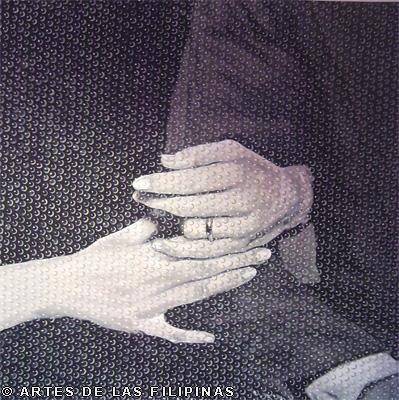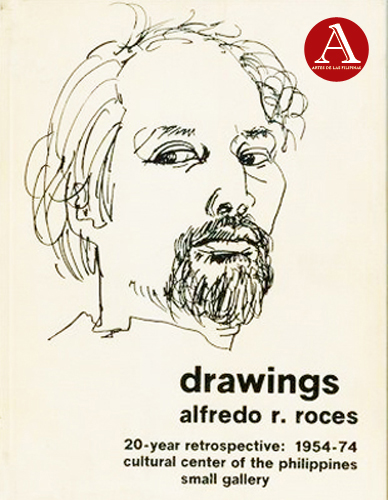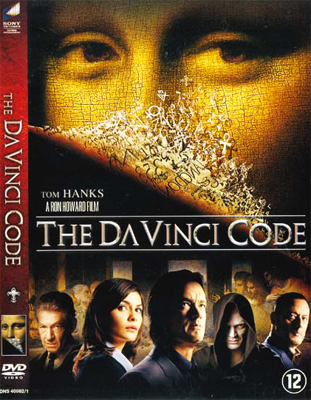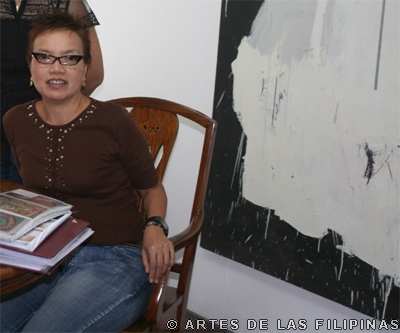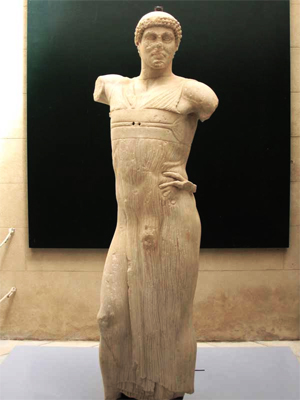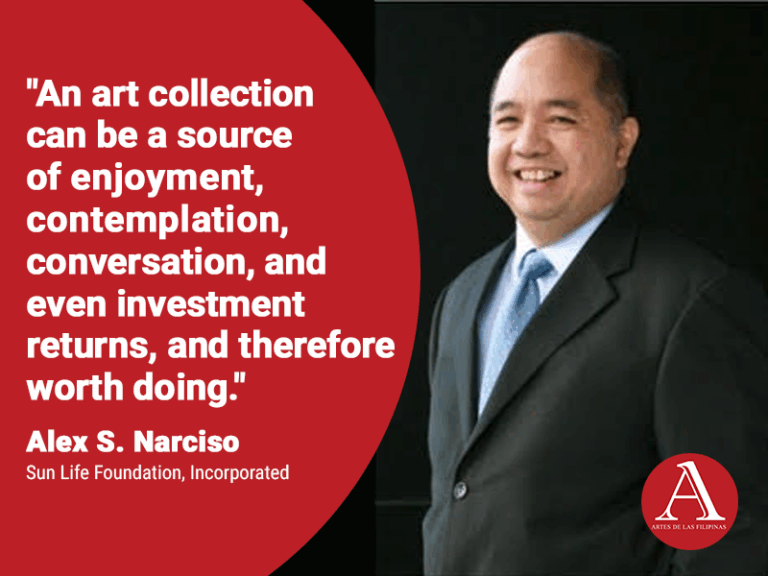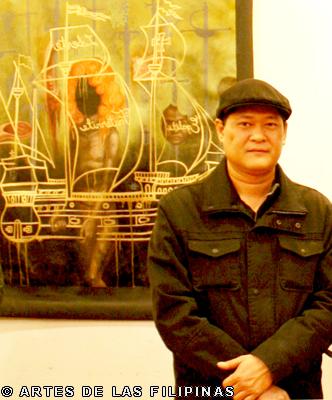
Jeho Bitancor’s Painted Truths
by Christiane L. de la Paz
October-November 2010 — Jeho Bitancor is one of the more important and astute contemporary painters in the country today. In the mid-1980s, he emerged with quasi-surreal paintings as his early explorations in art but has since made a mark as a purveyor of social realist paintings. In his breakthrough works, Bitancor imbues his statements, ironies and epigrams in the hope that knowledge and awareness may serve as an impetus for change. His mature works, often of a personal and contemplative nature, have engaged the themes of society, the Filipino diaspora and other nexus of issues, experiences and thoughts. Yet taken together, Bitancor’s works put the viewer’s attention to those aspects of migratory experience that shatter or reinforce the Filipinos attachment to its homeland and its readiness to adapt to a new country. After three decades of achieving a fairly notable position, patronage and approval, Jeho Bitancor continues to improve himself as a painter and works harder for his works to address larger segments of its wider audience. In this November feature, Jeho Bitancor provides an account of his life and painting career, his artistic process and ethics and accompanies the lively discussion with his thoughtful body of works, giving a vivid portrait of himself as both an individual and a painter.
Graduating from the University of the Philippines in 1990, what was your life like during the early phase of your career?
My early phase was characterized by uncertainties. I was trained as a studio artist first, majoring in painting before continuing my studies or second major in visual communications. I was aware then that pursuing a degree in fine arts right after graduation is a tough decision and a sure ticket to starvation unless you have an affluent family to support you. Having been raised from a family of simple means, I did not have the luxury of indulging on my own passion at the expense of not being able to contribute financially. I am the eldest among four siblings, and as typical as ordinary Filipino family can be, I was obliged to help.
What could be better than pursuing a lucrative career as an Applied Artist? For seven years, I was on and off employment as graphic designer and art director for leading ad agencies. But the contradictory dynamics between the ideals I pursue as an artist and the corporate world proved to be so philosophically and morally opposed that I walked out of job a number of times. Finally, my residency grant in the US in 1997 bade farewell to my advertising career. But the art of Visual Communications remained and was put into better use as I’ve rendered my services to cause-oriented and advocacy groups in the years to come. I did fund-raising campaigns for Caritas Manila for one. All the while, I was painting and joining art competitions.
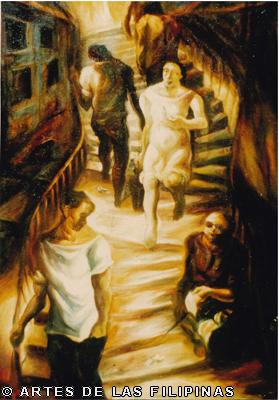
Oberpas (1995)
Tell me about the residency grant you received in 1997.
It was at the Vermont Studio Center in the US, an international artists’ colony located in the isolated but picturesque “Green Mountain State.” The grant is being awarded by the Freeman Foundation to two artists per country in Asia. It is a much- competed and juried by a distinguished panel grant as artists get to travel to the US and maintain a studio for free. The grant also includes meal, travel, shipping allowances and health insurance. All you have to do is work undisturbed and interact with artists from around the world for a period of three months. There were open studios, artist’s talks and consultations with well-known artists. It was surprising to note that my works were well received and admired there. At the end of my grant, I was given a solo show in the center’s gallery and they provided for my free travel to New York as well.
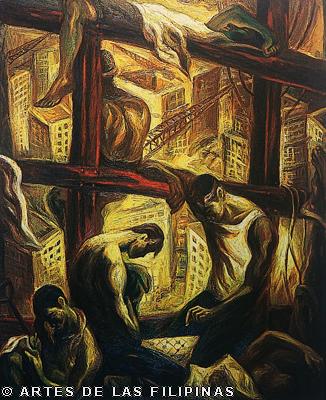
Siyesta (1995)
Was Fine Arts your first course?
Yes. I guess I didn’t have other options. I could be in other fields that do not require Math but I chose to pursue a more creative endeavor.
What Math subjects have you taken?
Just the required subjects for my course, Math 1 and 2.
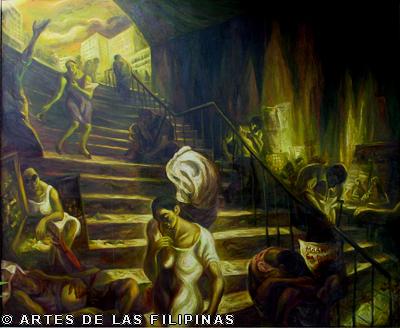
Lagusan 5 (1997)
Who are your contemporaries in UP?
My batchmates and classmates were Ferdie Montemayor, Bernardo Pacquing, Manuel Ocampo, Gaston Damag, Roma Valles and Ronald Achacoso, among others. I also shared a Chabet class with Marcel Antonio and Rock Drilon. Senior contemporaries include Manny Garibay, Karen Flores, Elmer Borlongan, Tony Leano, Mark Justiniani and Alwin Reamillo, among others.
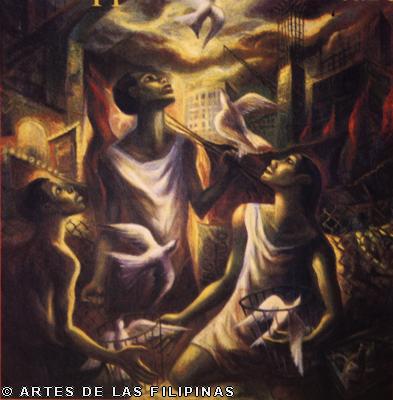
Musmos (1998)
Were you a star student during your days?
No. I wouldn’t put it that way, not in the sense that Alwin Reamillo and Tony Leano were star students. As a painting major, it’s hard to stand out because all my classmates were good and mostly are graduates of the Philippine High School for the Arts. When I majored in VisCom, I was being noticed probably because of my advantage in age and training. One of my teachers, the best and strictest, admitted that she has nothing more to teach me and recommended me for a scholarship abroad instead. Of course, it did not materialize as I was in the habit of dropping minor subjects and there was no scholarship for delinquent students.
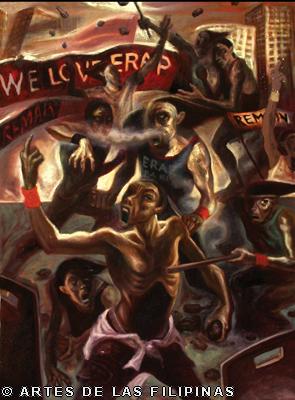
ERAPsyon (2001)
What have you been painting during your school days?
Under Chabet’s class, our outputs were very much into Neo-Expressionism and Post-modernism. My leaning towards quasi-surreal imagery was already evident and the influence of Social Realism was slowly emerging then.
After graduating, what was the first job you applied for?
During my third year in Visual Communications and also as a result of my practicum interview, I was offered a full-time job by Emily Abrera of McCann Erickson. I was being trained as an art director to head a new department in the area of Direct- Mail Advertising. My first taste of the corporate world proved to be over-bearing and as I have already acquired my discipline as a visual artist, I quit my job and went back to school.
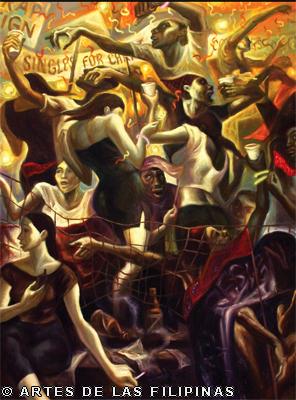
Rage Party (2001)
What does your job as an art director entail?
As an Art Director, I am responsible for providing visual solutions to marketing problems. Before a product is consumed, it has to appeal first to the senses and appetite. Influencing decision and action among consumers requires a lot of research, strategy and creativity. Specifically, I conceptualize and design TV commercials, print ads and collaterals. In medium-size ad agencies, this process is done mostly in partnership with a copywriter. In multi-national ad agencies, coming up with a concept is encouraged to be done independently, so there can be a purely visual concept from the Art Director and a text-based concept from the writer. I also oversee production process such as shoots, production design and printing. I was the Art Director for Samsung when it was launched in the Philippines.
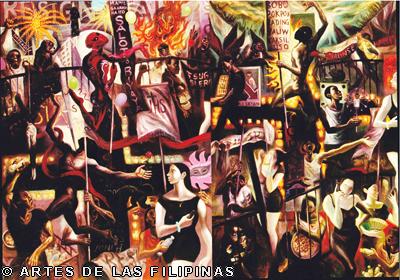
Rebolusyon (2001)
Because you quit your job quite soon and went back to school after, what was your source of income during that period?
I was illustrating for the college paper and children’s magazines and I also sell paintings from time to time.
After your stint in McCann Erikson, did you have another job?
I went from one job to another trying to reconcile the need to paint and the need to eat. Avellana and Associates, Philippine Adverstising Counsellors, Leadcom Asia and Communication Concepts were among the topnotch victims of my “attitude problem.” I performed well though even if my convictions were elsewhere.
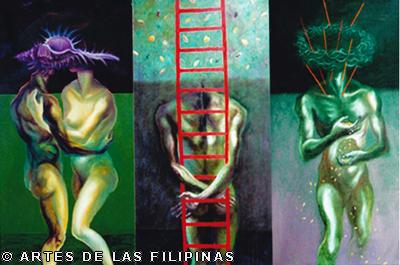
Introspection Exhibit (2002)
Are you referring to your “I am not happy with my job. I think I am better off elsewhere” as your attitude problem? Looking at it now, do you regret acting that way towards your job?
Exactly. No I don’t regret anything. I made the right decision.
How did your experience working in advertising firms help you in your work as a visual artist?
Advertising provided me a good training ground for harnessing my conceptualization skills, taste and processes. I learned how to focus and achieve impact through minimum means and trim down unnecessary details. Up to now, I rely heavily on an image’s expressive potential alone. Advertising also taught me how to organize which I was able to employ later as a cultural worker.
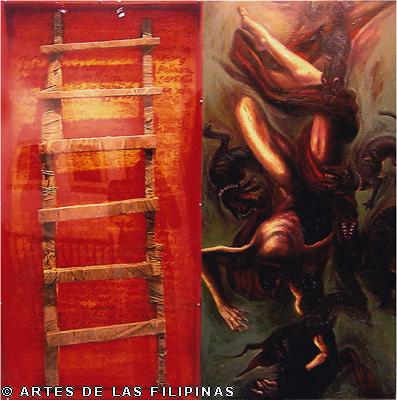
Nais Kong Tumulay sa Bahaghari Kahit Na Ang Bangungot Ay Kumikitil (2002)
You first entered the art scene in 1995. What is the status of the art scene during those times? Was the landscape of the art scene paving ways for young artists such as you?
I consider my entrance to the art scene to be in 1995. My first solo show sponsored by the Art Association of the Philippines under Ramon Orlina’s leadership. It was a time in Philippine art history where a group of young artists mostly contemporaries from UP banded together as Salingpusa. This group paved way for a brand of “socially conscious” manner of figurative painting that has inspired a generation of artists. People have always associated me with this group, but I was never a member. I get to participate in some of their activities. Our stylistic affinities may be a result of the shared passion towards social reform and our adept training in rendering figures from memory. I think we shared the same philosophy or school of thought. We dominated the art competition scene during those times and yes, the art scene was swept by young artists.
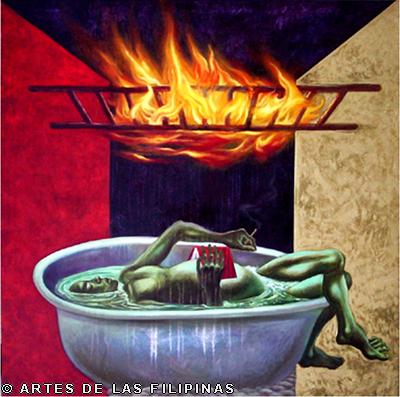
Armchair Revolution (2004)
What were the themes that you were exploring during this period?
In the mid-1980s and as a result of Roberto Chabet’s effective method in cultivating his student’s own language, I was already exploring my personal symbology that is characterized by quasi-surreal imagery. Then later at the end of the decade until the early 1990s, this imagery blended into Social Realist themes. From 1992- 2002, I was doing paintings based directly on observed and/or experienced situations. These works were done in monochromes and were rendered in heavy chiaroscuro and impasto-like application. There was a lot of intensity in these works and I am mostly known for these. In 2004, I have been exhibiting paintings similar to what I have already explored in the 1980s. These works were characterized by the use of color and symbolism but were all inspired by my reflections on society, the workings of ideology and lament on individual struggles. Now, I explore juxtaposing images and superimposing graphic elements on top of my traditional figuration.
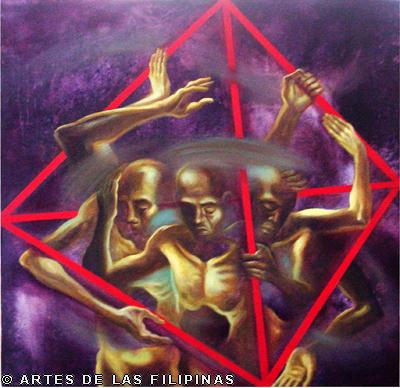
Kanlungan (2004)
Tell me about your first exhibit.
I’ve joined several group shows during and after college. But it was my first solo show that’s worth mentioning. It started during the Art Association of the Philippines’ annual art competitions in 1992 onwards. My entries have consistently landed on Juror’s Choice awards and two of the pieces were collected by the Singapore Art Museum. As a result, Ramon Orlina who was then AAP’s president offered the association’s help in launching my first exhibit. It took two years of following-up and telephone conversations until the show finally took place in 1995. The show was held in a makeshift gallery in Shangri-La Plaza as there was no better space for the twenty-one pieces medium to large- scale works. And Orlina, being a well -known figure was able to gather support for an unknown beginner. The show was well-received and reviewed and among those who attended were National Artist Napoleon Abueva , the CCP president, Rod Paras Perez, the late Odette Alcantara, Norma Liongoren and other artists. During the show, the Liongoren Art Gallery offered me a second exhibit and gallery representation while Prof. Eric Torres of the Ateneo Art Gallery secured one of the pieces for its permanent collection. There were a number of good opportunities that followed although I sold only one work.
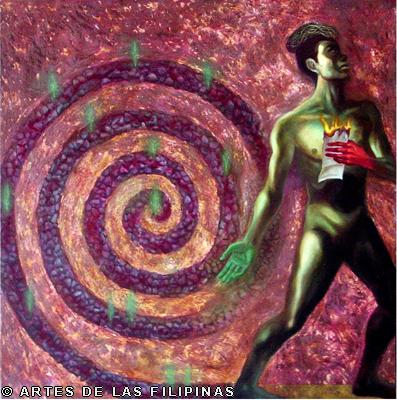
Road Less Travelled (2004)
Do you agree that the first exhibit of a painter could make or break his career?
Not at all. Establishing an audience and the artist’s evolution are slow and painful processes. And by “make” or “break,” do I equate these terms to fame and monetary rewards? An artist can be all the richer for his mediocre works while the unknown starving artist may be doing the more important works. In my view, the price tag is only a result of valuation which we all know can be manipulated. I also know of senior artists who spent most of their time and fortune securing their “immortality” while others remained true to their visions and were revered highly by peers irregardless of institutional recognition and market pressure. Lucky are those who were rewarded for what they truly represent and able to do. But I believe that the true measure of success is the artist’s body of works that speak of his conviction and contribution to the evolution of visual and intellectual culture. As for my first exhibit, it just opened the door for a continued practice and meaningful engagement with art.

Altered Identity (2006)
What is the first gallery that carried your works?
Liongoren Art Gallery. I did three shows with them.
Are you eyeing a particular gallery to carry your works during those days?
I wanted to be represented by Boston Gallery as most of my contemporaries were there. I was approached by its curator and I was able to mount a show.
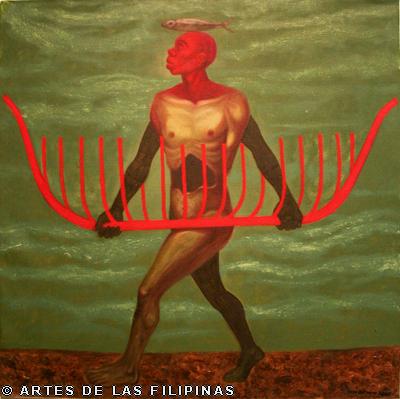
Being Red 1 (2006)
These days, which galleries represent you in Manila?
Some of my works are scattered around but I am represented by Liongoren Art Gallery, Blanc Art Space and Blueline Gallery.
Hypothetically speaking, which galleries abroad would you like to have your work collected and permanently displayed?
Maybe MoMA or Met or Whitney or Guggenheim. But honestly, I can only afford to dream of the National Museum of the Philippines or the Cultural Center of the Philippines. Being able to do so is already worth my journey.
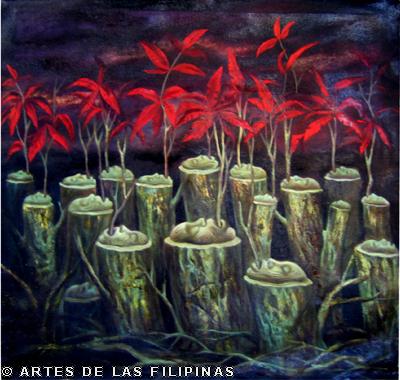
Tongue of Flames (2006)
Who among the foreign artists would you like to have a collaborative work in the future?
Maybe Damien Hirst, Lucian Freud or Sigmar Polke, if ever they are still alive or whenever the table has turned.
You have visited and joined exhibits here and abroad, what has been some of the memorable exhibits you have seen?
I was fortunate to see the Rauchenberg retrospective at two Guggenheim locations in New York in 1997. The first visit at the Museum of Modern Art was a surreal experience for me seeing the works that only existed in my mind through books. The “Starry Night” by van Gogh was very intense and moving. But what I would consider memorable to me was my show in Hanoi where I exhibited the huge “Memento Mori”. They said that a lot of Vietnamese artists were inspired by that particular work of mine and they personally expressed that to me.
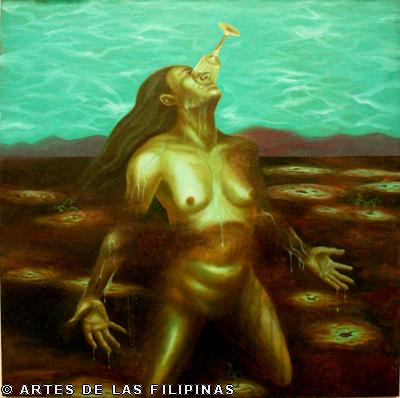
What You Sow, Shall You Reap (2006)
Aside from your Memento Mori, what are some of your memorable works?
Leytenya, Lagusan series, Siyesta,Takipsilim, Doon sa Bayan ni Juan, and Diaspora, among others.
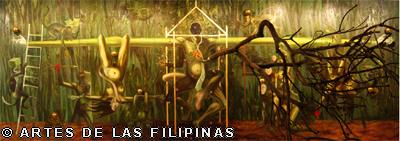
Memento Mori (2006)
In the local art scene, how do you present your ideas to a gallery of your choice to take you in and mount your exhibit?
Coming up with an idea for the show is a bit tricky especially from my genre since we are all informed and stimulated by the same environment and social conditions. But so far, the themes that I have exhibited have never been done before. I try to look inwards and confront my own biases. That way, I could focus on the things that I respond to and listen to what my instinct dictates in terms of interpreting a theme or subject. In my early years, I always try to discern the subject’s poetic potential since I dabble in poetry and was concerned with the literary aspect. I was also concerned with depicting the universal human condition through the simplest human situations and associations. Sometimes a minutiae can become a macrocosm of society or a tell-tale sign of the times. But in later years and up to now, I began to employ a more conceptual approach in producing a show. I also think that each person is unique and different. By tapping the core of ones being, one is able to see things differently and employ one’s stamp on the subject. I draw ideas from living life. My material existence and world outlook also play a big part in distilling them.
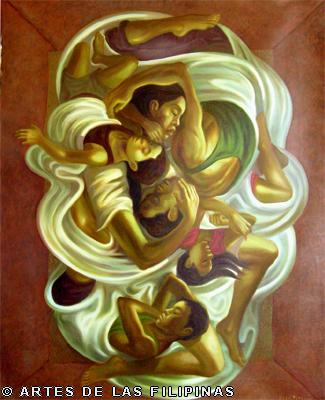
Habang Maiksi ang Kumot, Matutong Mamaluktot (2007)
Did you ever find yourself in a situation when your idea for your own exhibit has been executed by another artist?
Not with an idea for the show but there are a number of subjects or ideas for a painting that has been executed by other artists without my knowledge, especially those whose concerns are similar to mine. I try to avoid painting the subject as long as I can resist expressing my own “take” on it. But I’ll let the work possess its own integrity if I need to paint such subject. In recent years, I dealt with subjects that are my personal experiences and were processed in my mind as opposed to those directly observed situations.

Isang Daigdig (2007)
When you are in the process of working, who is the viewer you have in mind?
Not one in particular. But when I work, I think of a lot of things. Sometimes I think about the the validity of what I’m doing and its philosophical justification. I am aware that the contemporary art world gives much weight to the conceptualists who tackle artistic problems than the obvious social dimension in art. Somehow I felt trapped and belittled by my own practice. But the more pluralistic expressions nowadays strengthens my belief that telling “the Story of Maria” for instance, is as worthy as celebrating “the redness of red.” I also believe that artists must strive to contribute to art’s formal evolution apart from just dealing with its content.
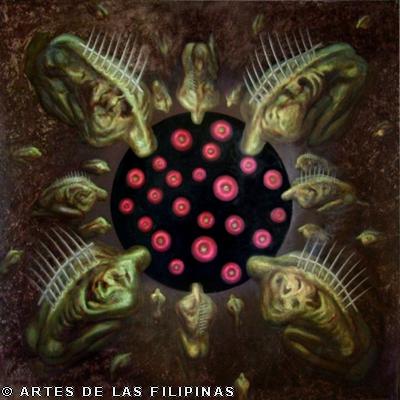
Diaspora 3 (2007)
Earlier you mentioned poetry as a reference in some of your works, can you share a poem that you have written?
PANAMBITAN (1997)
Ang pagkalat ng dilim sa siyudad
ay di ko dapat ipagluksa
ikamo, habang puyat na mata’y
nakatitig, di naghahanap ng sagot
ni pang-unawa.
Sapat na ang kalam ng sikmura
upang itago sa kolorete’t lipistik
ang tila bangkay na mukha.
Suyurin mo man
ang madidilim na kalyehong
may pikit-dilat na neon;
luklukan ng mga hayok,
panginoon ng pilak at eleksyon
Ay di ko sukat ikabahala
pagka’t di ako ang nanunulay
sa esterong burak,
pugad ng galis, malaria
kolera at garapata
Di ako ang sisigsigin
ng lamig tuwing umuulan,
o magdidildil ng asin
kung tag-araw.
Di rin ako ang magpapatahan
sa palahaw ng sanggol na gutom,
sa tungayaw ng asawang lasing,
sa inumang na punyal ng haragan,
at sa lahat ng bangungot
na kaakibat ng dilim.
Di ako… ang titiyak
na payapa ang gabing lilipas
para sa iyo, para sa akin.
Kaya’t huwag, ikamo
huwag mo akong alukin ng buwan at bituwin
kung kapwa `ta itataghoy
ang pilat sa katauhang wari’y
inilagda na
at ngayo’y pinagsasaluhan natin
sa dilim.
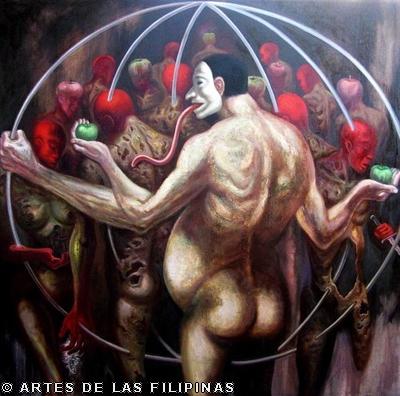
One World (2007)
Are you a member of any artist’s group?
I am the founding president of Baler Art Group based in Aurora Province. It was a way for me to extend my social responsibility as an artist. I was also an active member of the AAP during its heyday and was still highly regarded by the art community in the 1990s. For a time and until my relocation in the East Coast, I was a member of the Central California Art Association.
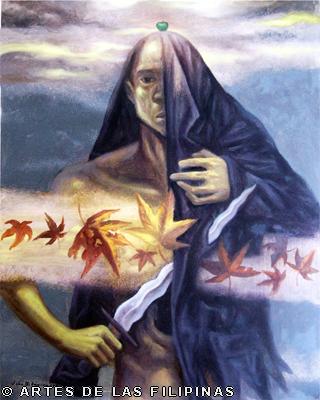
Taglagas (2007)
What do you think are the advantages of being part of an artist’s group?
Generally, a group creates for an artist a sense of community or a second home from where to gather support and generate insights and feedbacks regarding one’s individual growth. At times, it can be a recreational and social integration affairs but it can also be a serious venue and avenue for launching worthy agendas.
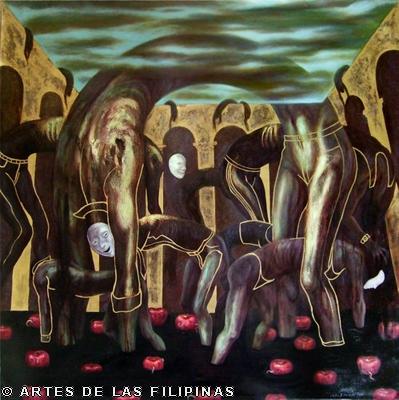
Adrift (2008)
And the disadvantages?
Over-emphasis on collective decision or the lack of it creates confusion and disintegration. Professional jealousy and the loss of individuality can also occur. Institutional organizations survive because of the constant replacement of people manning and embodying them. Still, most groups are dissolved because of the inability to cope with the prohibitive cost of maintaining them.
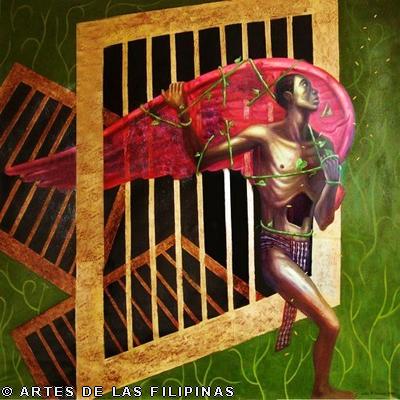
Flight (2008)
You mentioned the Central California Art Association. Are you the only Filipino in the group? Please give some background about this organization.
Yes, I am the only Filipino artist there. It’s the most active art organization in Central Valley. Before I migrated, I have already researched about this group and I joined them weeks after I arrived. As a result of my two entries for the group’s annual juried show, I was featured in a solo show a year later.
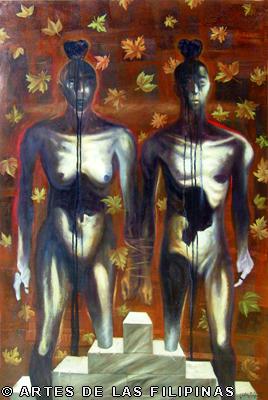
Pinagsasaluhang Luha (2008)
Have you ever won any important awards?
The most important awards I consider were those given by the AAP, the ASEAN and US grants, the Dangal ng Aurora award and the CCP 13 Artists Awards.
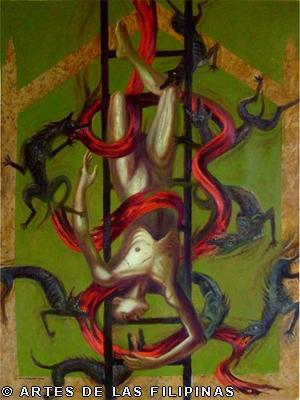
To Kill A Dream (2008)
Do you think awards help make a painter become commercially recognized?
I’ve seen young artists whose careers and commercial viability were launched by regular art competitions. And there are those who remained anonymous despite winning consistently for years. Some can capitalize on awards to raise their work’s price, but then again some cannot. It really depends on the artist’s works whether they are acceptable to a particular audience or there is a mechanism applicable that would generate money for the works. The really important awards place value on the artist’s work whose status is elevated by virtue of the award. But in my opinion, commercial success does not amount to an artist’s worth.
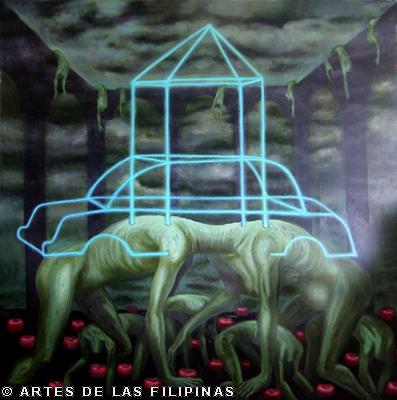
Trapped (2008)
Which among our local painters had an influence on you?
During the formative years, it’s but normal to be inspired or absorb by what you think is essential from the artist that you admire. I would acknowledge the things I learned from some or a single work by Danny Benjie Lontoc and Mark Justiniani.
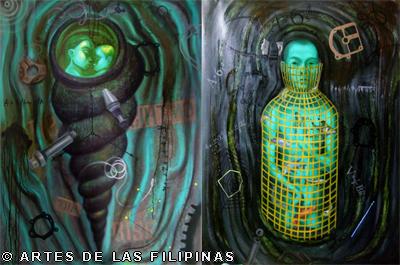
Bantang Panganib (2009)
In terms of style, who are you drawn to painting during your student years?
In high school and early part of my college days, I saw the world through the eyes of Vicente Manansala, Cesar Legaspi and Carlos V. Francisco. Later, I was particularly drawn to the German expressionists such as the works of Otto Dix, George Grosz and Max Beckman. Francis Bacon the painter and Dali also had an impact on me.
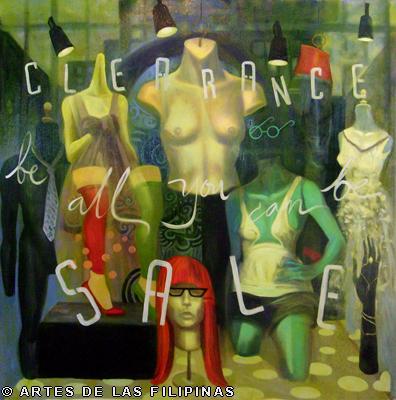
Disembodiment (2009)
As you get to know the works of our National Artists, who have remained relevant to you?
Victorio Edades is relevant because he championed modernism in Philippine art and artists veered away from the shadows of Velasquez through Amorsolo and Luna to Picasso and Cezanne. Later however, Filipino modernists were able to incorporate borrowed forms with native sensibilities and subjects. But judging from sheer talent and contribution alone; I only respect Fernando Amorsolo, Guillermo Tolentino, Carlos Francisco, Vicente Manansala, Cesar Legaspi and Napoleon Abueva. The other two National Artists were very much like Paul Klee and Jackson Pollock and the other one is a clone of Rufino Tamayo. And except for H.R. Ocampo, the rest were just “Presidential Choices.” Among the lot, I also admire the virtuosity of Carlos Francisco. His lyricism and impeccable sense of design and composition are still unsurpassed. Napoleon Abueva’s sculptures are still hallmarks of sophistication and intelligence.
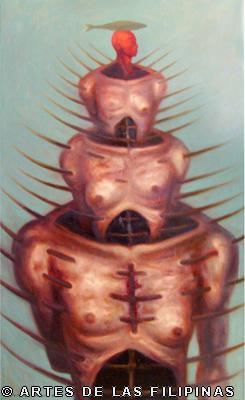
Inheritance (2009)
What about foreign influences?
I was fascinated with the way Picasso altered our perception and the way he reconfigured our definition of art and reality. I was fascinated by how Duchamp and Beuys were able to redefine the contexts from where artists, art objects and art making operate. I am fascinated with the way art evolves but it does not translate as an influence to my own art-making. I’d like to emphasize, however, that I am still struggling to be the kind of artist that can generate a context rather than simply being driven by it.
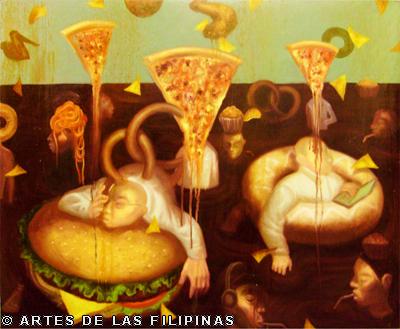
Lunch Time (2009)
Among the artists of your generation, whose works do you find meaningful and relevant?
Alwin Reamillo, Alfredo Aquilizan, Manuel Ocampo, Gaston Damag, Mark Justiniani and Elmer Borlongan, to name a few.
Who handles the business side of your profession?
Myself, the galleries and some collectors who support me.
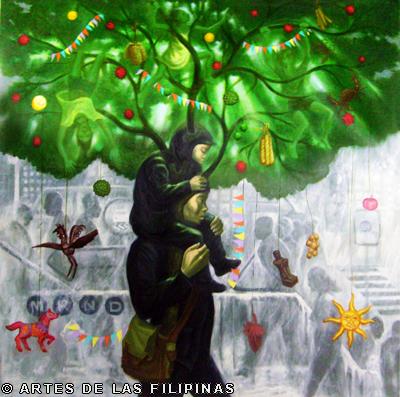
Missing Home (2009)
Do you have an idea of the profile of collectors who collect your works?
I have a few able and respectable collectors who have supported me through the years. They are distinguished personalities in their own fields.
Do you have other nationalities who follow and collect your works?
I was informed that the Director of the Singapore Art Museum and a certain High Commissioner of Malaysia are new collectors. There are also some Indonesians but they only buy during shows.
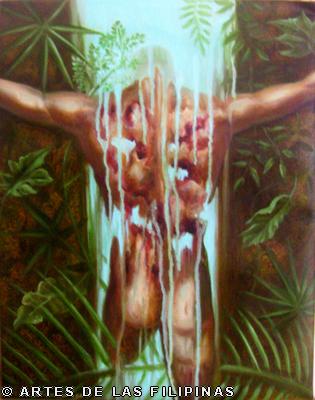
Regeneration 2 (2009)
Let’s say you are a collector with ample means, which works are to be found hanging on your walls?
Among the Filipino artists I would collect Luna, Amorsolo, Manansala, Francisco, Ocampo, Legaspi, Alcuaz, Zobel, Chabet, Aguinaldo, Luz, Joya, Cabangis, Vinluan, Lao Lianben, Albor, Tence Ruiz, Doloricon, Fernandez, Soriano, Delotavo, Dalena, Olmedo, Baens Santos, Jose Legaspi, Leaño, Borlongan, Justiniani, Mallari, Montemayor, Manuel Ocampo, Aquilizan, Reamillo, Ventura, Esquillo, Nuestro, Cainglet, Jarque, Javier, Dreo, Coquilla, Cruz, Gonzales and Adrao, to name a few.
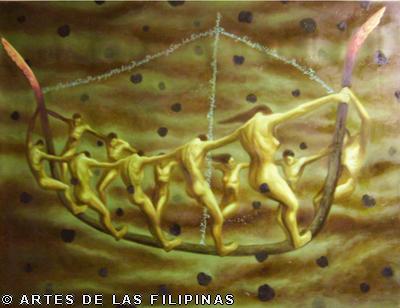
Sayaw sa Utos (2009)
What has been the best compliment said about you or your work?
Some can sense poetry as paintings are narratives, after all. Others have noticed my flare for composition and the way I handle light is quite different, as they would say. They are referring to my early works.
And what have you been criticized of?
That my paintings are so sad, dark and gloomy, to the point of being defeatist. Again, they may be referring to my early works.

Struggling Artists (2009)
Who among the art critics would you want your works to be reviewed?
Patrick Flores, Alice Guillermo and Eric Torres.
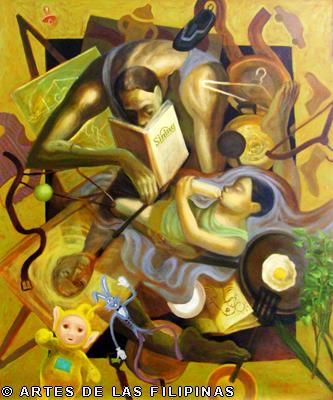
The Multi-Tasker (2009)
You have been around for two decades already, what are some of the changes that you have observed? Do you like these changes?
For one, the trend has shifted from enticing the viewer with the superficiality of displaying material and the complexity of its construction, ala Nevelson, to just puzzling MTV-like visual circus. In the 1980s, a painting contest is characterized by sculptural objects such as assemblages, high-reliefs and found objects. Young artists of today seemed to have gotten tired of past iconography such as the photographic transfers on mixed-media, classical figuration, social content etc.. Instead, they focused on cartoon or comic-like articulations of their vague concerns. There is also the resurgence of Filipino artists mimicking Lichtenstein and Murakami. I believe trend-watching is still in vogue and a lot of young artists have made careers out of outright copying of other artists’ styles, who are winners in major art competitions. The only saving grace of this is that Filipino artists are inspired by Filipino artists. Moreover, abstraction today is relegated to gutter level by those who want to have a fat bank account without a hint of what abstract art is all about. The worst scenario is heralded by the once respected association of Filipino artists led by commercial artists, who are a step apart from the Mabini painters.
But of all the sour notes I just said, there are positive ones such as exhibitions after another of respectable young artists mushrooming in huge galleries around Manila. It is also worth noting the expanding recognition of Filipino artists within the Asia-Pacific region. Some have become staples in Biennales around the world. And though I don’t really abide by auction results, the competitive edge shown by some Filipino artists indicate a change in valuation and demand, however, superficial they may be. Lastly, the historically and philosophically opposed Conceptualists and Social Realists were increasingly drawn towards crossing borders. The former, realizing their humanity now also tackles their vulnerability and leaving human imprint on objects. The latter is obviously tapping their cerebral capacities to appeal on emotions and intellect through untested means.
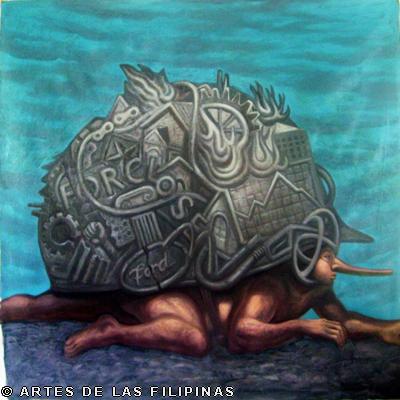
Usad Pagong (2009)
I’d like to know some of your work ethic as an artist.
I work even if I don’t want to especially if there is a set time frame and the clock is ticking. I consider myself lazy and because of poor time management, I have been forcing myself to complete a show in less than two months for a number of times already. And I will never do a mural in twenty-one days again.
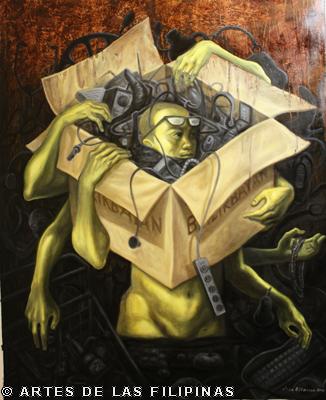
Alien (2010)
And what is it that you won’t compromise?
The quality, at least from my own judgment.
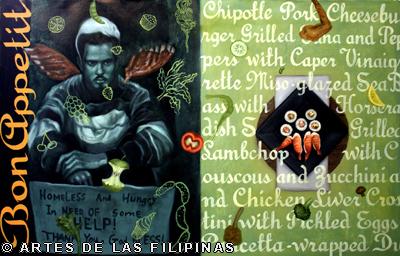
Bon Apetit (2010)
Do you think your works will hold a place in Philippine art?
I can only hope so. If my works are to be placed in context relative to my historical existence, then maybe. But then again, valuations change over time. Really, it’s not for me to say. I will just be grateful for instance to a life spent climbing having declared so as a mountaineer. People can trash my souvenir pictures but never the vista I enjoyed and struggled for during the climb.
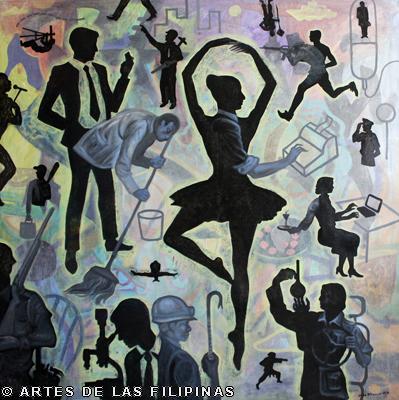
Career Change (2010)
Tell me about you, your growing years. Where are the Bitancors from?
I was born on October 24, 1967 in Aurora, Baler. My father Gregorio Bitancor was one of the Bicolano migrants who settled in Baler, Aurora in the early 1960s while my mother Peladia Leander is a native of the town. My mother who was a public school teacher prides herself on being a descendant of a musical clan of Ferreras while my father claimed to be a grandchild of an amateur painter in Naga City. Together, they thrived on simple means and raised a family of four children. My siblings and I acquired our elementary education at Baler Central School where my mother taught. Our high school years were spent at the Mt. Carmel College in Baler. Before our formal schooling, my father would always bring home donated books from abroad from his work and I would leaf on them endlessly wondering on their colored illustrations. That was my first encounter with Francis Bacon’s works which I found monstrous and scary. My mother also brought home calendars and magazines with colorful reproductions of Amorsolo paintings.
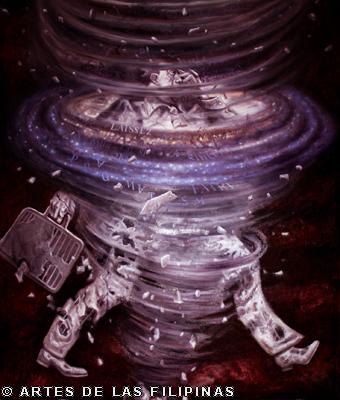
Center of Universe (2010)
Are you the only artist in your family?
No. My youngest brother Johann Bitancor is a graphic designer and is into painting now.
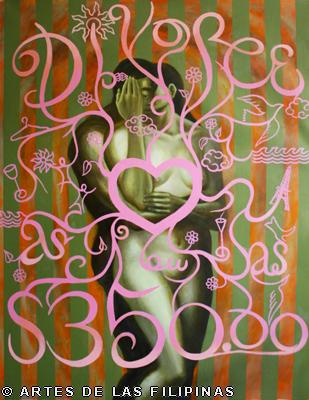
King 7 Queen of Hearts 2 (2010)
What is the status of the art and artists in Baler? Who are the artists that the town has produced?
Cultural development in Baler started as artists’ initiative. We implemented voluntary cultural work in the late 1980s and it has reaped some rewards for the community that needs much-needed cultivation of appetites. Still, the gap has to be filled by properly trained and educated professionals who are in some degree willing to invest part of their lives for the good of the community. No amount of patronage in the form of providing venues can suffice for the quality of works and arts management from which our local artists will only gain respect from, especially from the larger art community. By these, I am referring not only to artists but to trained gallerists, curators and art managers. Enlightened political leaders must step in to help provide resources for the few who seek to venture into not so popular areas of human endeavor.
Through the years, Baler has produced different visual art fields practitioners, upcoming artists and enthusiasts alike that include Maria Cruz, an established artist based in Australia,Clemente Aragon, Joel Vedad, Johann Bitancor, Vincent Gonzales, Sherwin Gonzales, Noli Guerrero, Caesar Gonzales, Marvin Soriano, Federico Mauro, Anthony Genosa, Ibu Querijero, Ani Querijero, Rommel Espinosa, Rossana Querijero, Roy Buen and a host of other students. Most of the names I mentioned have benefited in one way or another from the early efforts of Baler Art Group. Of late, Senator Angara and Gov. Bellaflor Angara-Castillo have extended their support to accelerate the local talents’ access to national institutions such as the AAP and the NCCA. Likewise, literature has also been introduced in the province through the Sining Silangan’06 funded by the Provincial Government under Gov. Bellaflor Angara-Castillo.
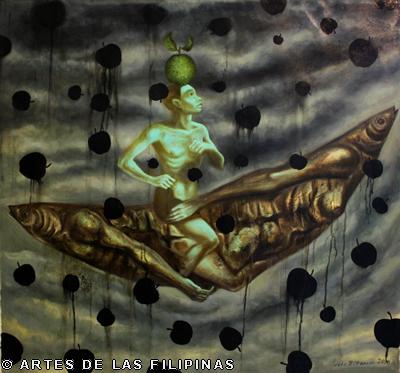
Leap of Faith (2010)
How would you describe your early years living abroad?
I stayed briefly in California so I stared mostly outside the window during the first days. I was trying to decipher what could possibly ignite my passion on that cemetery-like environment of concrete houses with no human presence. It was so manicured and pretty. I did a lot of biking instead and explored the place. In the afternoon, I painted abstracts on paper to get the “feel” of it. I eventually ended up doing unfinished projects from the Philippines. It took some time before I got hold of new subjects that are reflective of my new “reality.”
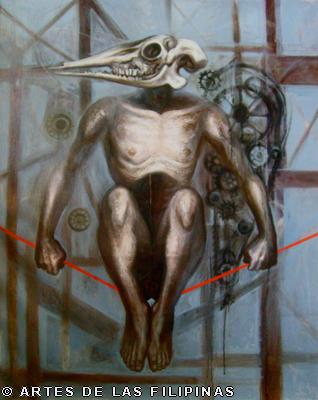
Mortal 2 (2010)
Over the years, have you acquired some habits or “rituals” when you paint?
Music is integral in my process. I listen mostly to ambient, chill-out and new age for inspiration. For agitation, I listen to 80s rock and some Filipino musicians like Joey Ayala, Gary Granada and Dong Abay. I have outgrown jazz fusion and so I listen to reggae instead to feel good. I also follow my studies but I provide a room for improvement.
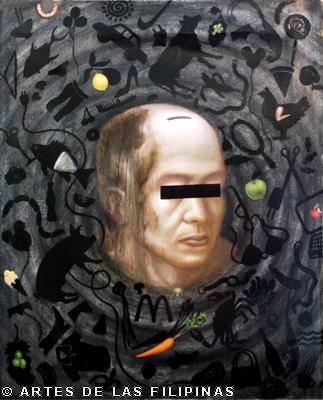
Rainy Days Aren’t Over (2010)
Are you only into oil paintings?
I am mostly into oil paintings. I did some installations before but the logistics and expenses were prohibitive. I have tons of drawings but mostly for studies and seldom as finished artworks. Even if I want to, the physical and spatial requirements of sculpture prohibit me to do so. I will just paint my ideas for sculpture.
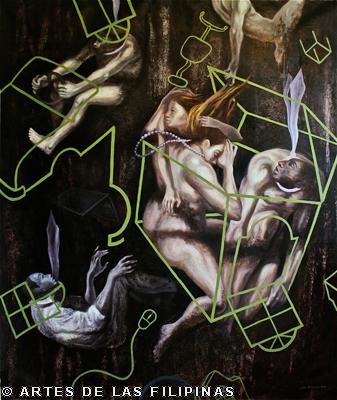
That Sinking Feeling 2 (2010)
How do you manage your year? When are you in Manila and which months are you in New Jersey?
I went home for a show in 2008. Most likely, I will attend my shows in 2011 in Manila by December. My year is typically spent working on two to three shows, some group shows and commissioned works.
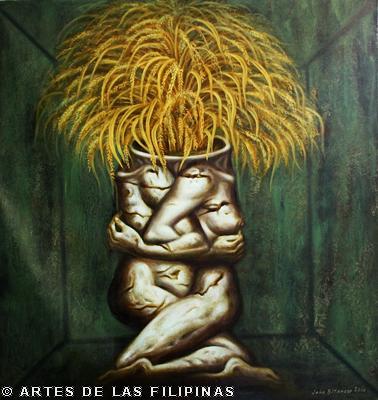
Well of Hope (2010)
I’d like to know what you find different in terms of living and working in Manila as a visual artist and living and working abroad as a visual artist?
In Manila, we can afford all the help we need to focus on our work. Living abroad entails adding up the workload like household work and childcare on top of our routine. Add to this your anonymity and obscurity as it takes a while to establish one’s reputation and audience. It is good, however, that my career outside the US has kept me busy for years. On the other hand, it is advantageous to be in close contact to works and events that would otherwise be in reproductions and news only. It also feels rewarding to deliver the message directly to intended audience. And although I am not now engaged as before in our country, I am doing what I can to deliver the goods and get the message across.
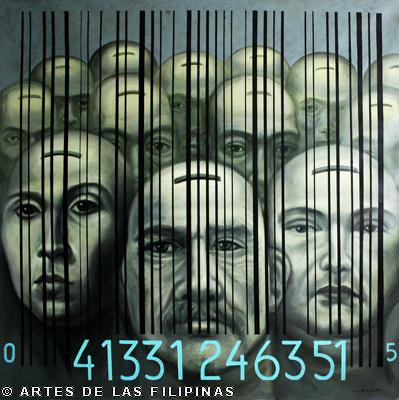
Thrift Heads (2010)


